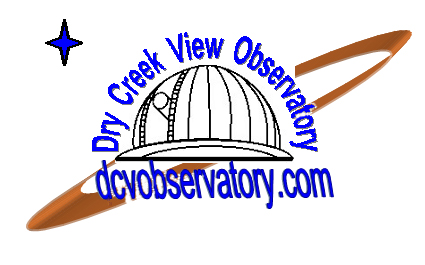Go
to Astronomical Viewing Blog Archive
Go To the Beginning Post
Tonight I decided that I needed to
make a Christmas Card to send to all of my friends. So, I took a
picture of Alnitak and the Flame Nebula. I purchased a "Filter
Box" from Hutech that I am not supposed to use until Christmas.
But I needed the "Cross Screen" Filter to make the Star
Burst affect. The card is pictured below.
Tonight I got a chance to do a little
photography. The target was a little known galaxy called NGC 2403.
The night was clear, and I used the Focal Reducer to capture the
image. In the future I will try the same picture at full f/11. The
duration would be a little more than double the exposure time. I
took the shot at 4.5 minutes at f/7.1. If I do the same shot at
f/11, the exposure time would be 10.8 minutes. To get the same 10
frames to stack, the total time of the photo session would be approximately
3.5 hours. Below is the photograph that I took. The time includes
the noise reduction time of the Nikon which effectively doubles
the overall duration.
NGC 2403 Galaxy
f/7.1, ISO 5000, Exposure 4.5 Minutes, 10 Images Stacked
November 27, 2012
Tonight was a night of "Outreach"
to some scouts form Oak City. Five young men ages 14 to 16 and two
leaders came to see the "Dry Creek View Observatory". The
only problem was that the moon was completely full, and to compound
the matter, high wispy clouds moved in about and hour before they
arrived. I was able to show them the "Control Room" and
explain how astrophotography is taken. I then showed them how the
scope and cameras are controlled from the Control Room. Even though
it was cloudy, we were able to see the full moon and Jupiter through
the clouds. The night was a success, but they want to come back perhaps
in January when we will be able to see M42 in Orion along with other
deep sky objects.
Since the moon is high, I decided
to take some pictures of the Moon and Jupiter. The moon shot I
have done before, but this time the Moon is a little fuller, and
my focus was better. As for Jupiter, I set my camera to ISO 320,
Exposure 1/500 sec., and took 100 pictures at 1 second intervals.
Eighty five of the pictures were usable and I stacked them using
RegiStax 6. For my first attempt, I believe it turned out OK.
Below are pictures of the Moon and Jupiter. I also took a picture
of the Globular Cluster M 2. It was ok, but I believe I can get
a better picture when the moon is down.
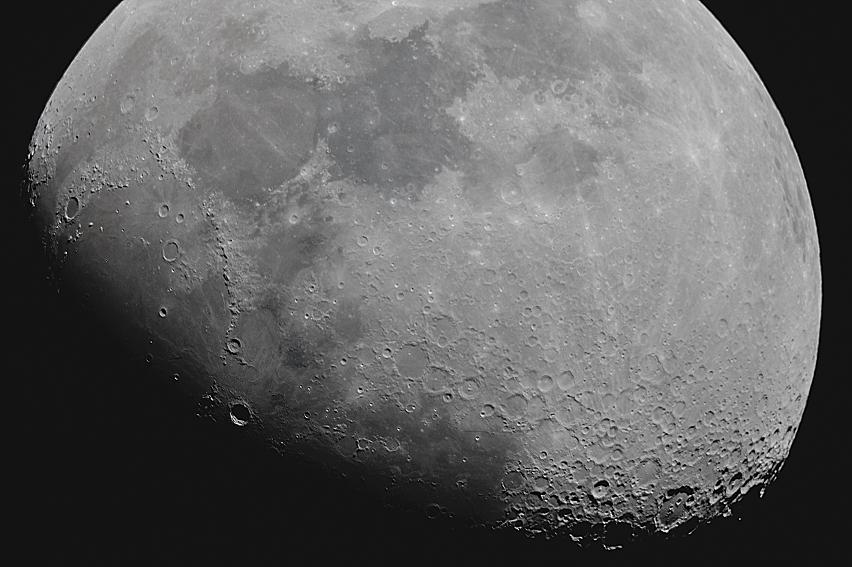 _
_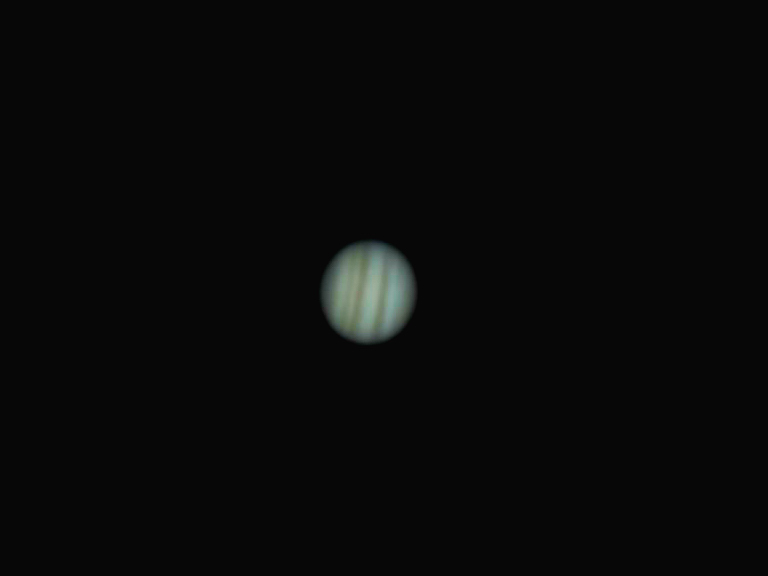
The Moon ISO 400 Duration 1/250 sec.________Jupiter
ISO 320 Duration 1/500 sec
Both of the above pictures can
bee seen full size in the Gallery
November 20, 2012
Tonight was a night of viewing.
The half moon was high in the sky thus washing out any hope of
picture taking of deep sky objects. My technique of focusing is
better now than when I took the picture of the moon earlier this
spring. I want to take it again perhaps during the Thanksgiving
Holiday when I can devote some time and not worrying about getting
enough sleep for my day job. Tonight the moon was great to view.
The contrast along the terminator was amazing. I also viewed Jupiter
for the first time in months. It is just rising in the east. I
tried the moon filter and viewed the planet. This also gave more
contrast to the belts. Even though the moon was high, M 42 Orion
and M 31 Andromeda was viewable.
November 17, 2012
I finally broke down and bought
me a filter holder that will allow me to take pictures through
a filter. I purchased the filter holder at hutech.com
it is model number 7519 and associated adapters to fit my camera
and scope. Once I get the holder, I will take pictures of it and
place it in my equipment section. It may be after Christmas, that
I can post the pictures as my wife says it is a Christmas present,
and I cannot use it until then. That makes for much more anticipation.
As for my viewing and picture taking, I have not had time to use
the observatory. With my day job taking me out of the state, and
cloudy nights, there has not been much opportunity. I am looking
forward to the Thanksgiving Holiday so that I can have some time
to observe. The moon will be up, but I will able to find targets
for future picture taking sessions.
October 21, 2012
No matter how much you do something,
there are always new things to learn. Today I had reinforced in
my brain that there is a difference in 8 bit color processing
and 16 bit color processing. The photo above under the October
19 blog, was processed with 8 bit color. The photo below which
is the same 10 stacked photo is processed in 16 bit color. Upon
inspection it appears that the photo above is brighter, but the
16 bit processed photo is more of a true color and it shows greater
detail.
NGC 7293 Helix Nebula "The
Eye of God"
(16 bit Color Processed)
October 19, 2012
At last, I finally had a chance
to take a picture of the Helix Nebula NGC 7293 sometimes referred
to as the Eye of God. This planetary nebula is in the Aquarius
Constellation and is very low in the Southeast horizon this time
of year. Taking this picture was difficult as it is faint, and
getting the exposure time just right took a lot of trial and error.
I am pleased how it turned out. The center star is very visible
and the stars are round. The autoguider was tracking well during
this exposure. The picture is shown below. A large version is
shown in the Astrophotography Gallery.
NGC 7293 Helix Nebula "The
Eye of God"
(8 bit Color Processed)
October 6, 2012
This has been a week of outreach.
Tonight, the Peterson family from Oak City came to see the observatory.
There were 6 total in the group. It was cold around 38 degrees
in the scope room. The warm room was a comfortable 72. The family's
small children were not dressed for the cold scope room, so the
viewing went fast. We saw the the same objects that were shown
to the young men on October 2.
October 2, 2012
Tonight was a beautiful night to
view. A youth group from Oak City came to see the observatory.
These young men were 16-18 years old and were very interested
in photography and astronomy. There were four young men total
in the group. My son Brent gave an explanation of the cameras
we use and why the light sensitivity (ISO) of the cameras is very
important in astrophotography. He also showed some pictures pointing
out the importance of "Polar Alignment", "Stacking",
and "Autoguiding".
After our eyes adjusted, we were
able to see M 13, M 57 Ring Nebula, Swan Nebula, M 31 Andromeda,
Albireo and Mizar. It was a fun night.
September 29, 2012
Not much picture taking the past
week with the moon being full. I have however, had fun observing
the moon as it grew into a full moon. I have been looking over
my astrophotographs and decided to redo some of the earlier photos
I took of M 51, M 101, and M 81. These photos were all single
shot pictures and not stacked. I think they turned out well, but
I think I can get more detail by using higher ISO, shorter duration,
and stacking the photos. If it works as it should, I will do the
same with the rest of my pictures. I have also been busy posting
on the "Astronomy Forum". Allot of fun things to explorer
on that form.
September 16, 2012
The last two weekends have been
fantastic as far as viewing is concerned. I am having too much
fun taking pictures of the cosmos. Friday night, I tried my luck
at the Lagoon Nebula. This nebula is very big and easily seen
through the scope. Taking pictures presents a challenge similar
to the Orion Nebula. My goal was to capture the center "HourGlass"
and single center star without blowing out the center. I accomplished
my goal. The picture of M 8 Lagoon Nebula is shown below. A larger
version can be seen in the Gallery.
M 8 Lagoon Nebula in Sagittarius
September 9, 2012
Last night was a great night for
taking photographs. The target for the evening was M 31 the Andromeda
Galaxy. I have taken a photo of this galaxy before, but my scope
focal length is so large, I could not get the entire galaxy in
the field of view. Therefore, I used a 300 MM lens and piggybacked
it to my scope. With the wide field of view of the 300 MM lens,
I was able to capture the entire galaxy and surrounding galaxies
and stars. I took 11 shots at 2500 ISO with a duration of 2 minutes
per shot. I stacked them using Deep Sky stacker. A comparison
of the close up and wide angle is given below. In the Gallery,
I have the full size images.
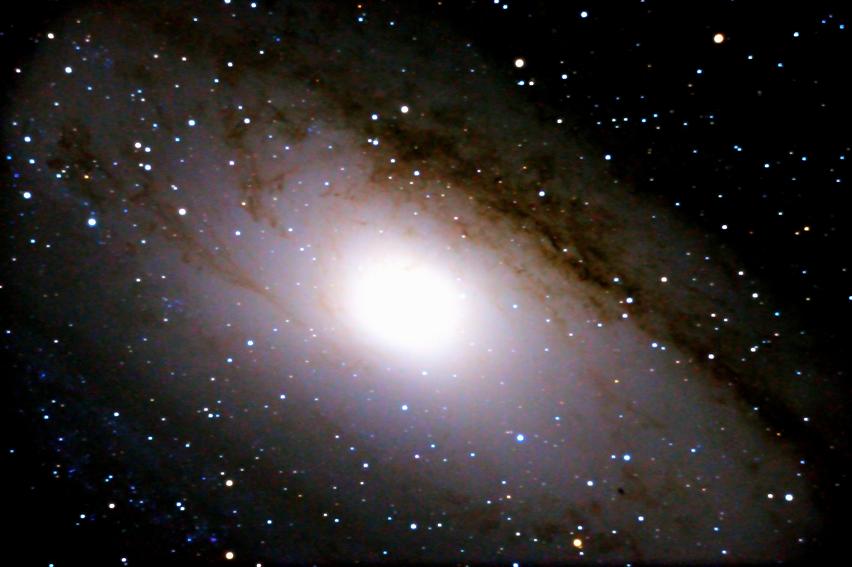 __
__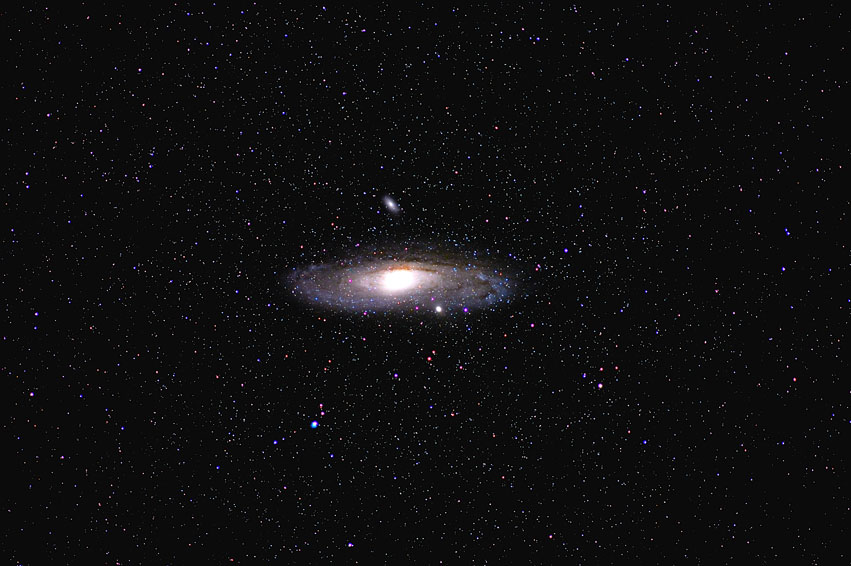
____M 31 Full 3910
MM Focal Length________M 31 Wide
Angle 300 MM Focal Length
September 4, 2012
As indicated in the previous post,
I was able to take some pictures on August 18, 2012. I finely got
enough time to process the M 57 pictures I took that night. I intentionally
underexposed the photos to see if I could compensate for the lack
of exposure with the Nikon Software Capture NX 2. The experiment with
exposure worked, but there is still some detail left out. I took 10
photos and stacked them using Deep Sky Stacker. There is a small galaxy
next to M 57 designated IC 1296. This Magnitude 15 galaxy is not visible
in the underexposed picture. I was able to see the galaxy with a much
longer exposure, but I did not have enough time to take 10 photos
to stack them and get the galaxy. That project is for another night.
The photo M 57 is shown below and I am happy how it turned out, but
there is room for improvement with details.
M 57 Ring Nebula
August 17, 2012
This has been a frustrating past two
months at the dark of the moon. I have been waiting for a night that
is clear and dark. I have managed to get a few hours in here and there,
but nothing substantial. Every time I setup the guide scope, a cloud
crosses its path and sets off an alarm. Tonight, I was able to take
a picture of the Ring Nebula M 57, but I could not take enough shots
to allow for stacking. The clouds kept rolling through. The picture
I took was fare, but not what I want to post in the gallery. I will
be patient and wait for a clear night. Tomorrow looks good according
to the clear sky chart, but as my luck the past few weeks would have
it, it will cloud up as soon as it gets dark. The M 57 nebula is quite
small, and therefore creates a challenge to "Blow the Picture
Up" (zoom in). This will be a good test of my son's D 800 Camera
which supports 36 mega pixels as opposed to the D 3 which only supports
12 mega pixels. If the sky is clear, I will try and get the picture.
I am hoping for six 5 minute photos of the nebula so that I can stack
them. Due to the cameras internal noise reduction algorithms, it will
take 10 minutes a shot. In other words, it will take one hour to complete
the process. I hope I can have "CLEAR SKYS" before the moon
washes out the pictures and I will need to wait another month.
August 12, 2012
I finally got all of the kinks worked
out of the web page update. The "Roll Over" images worked
well and I believe it is a much cleaner presentation of the Gallery.
Check out the Gallery, it has the new posting of the wide angle view
of the Lagoon and Trifid Nebulas.
August 9, 2012
Finally a night without clouds or Moon.
Tonight I played around with wide angle photography. I used a 300
mm lens and piggybacked the camera to the scope. I was able to take
the Lagoon Nebula along with the Trifid Nebula. I then took a close
up shot of the Lagoon.
I have also been working diligently
on the web site, particularly the "Astrophotography Gallery"
I completely revamped that page. The pictures were becoming crowded
and the explanations were difficult to maintain. Therefore I made
the tables that are there now. It is much easier to add pictures and
it is also easier to navigate the page. I also got rid of the flash
buttons at the top of the page and inserted roll over buttons. This
will aid with portable devices such as Ipads.
July 21, 2012
One of the problems of having astronomy
as a hobby is that you are at the mercy of the sky. Hence the valediction
of the Astronomer "Clear Sky's" is uttered at the end of
any correspondence. Recently in the Utah area where I live, the sky's
were clear when the moon was high in the night sky, but now that the
moon phase is perfect (no moon in the sky) for astrophotography the
sky's are cloudy. I have done some web cleanup, and added a link to
get you to the latest Blog post. Other than that, I hope everyone
has "Clear Sky's".
I was able to take the following picture
tonight. See the Gallery for Photo details.
Trifid Nebula M20
July 3, 2012
With the fires abating in the mountains,
and the smoke clearing, I have finely been able to do a little observing.
The moon is full which puts a damper on deep sky photography, but
Saturn as usual is beautiful. Along with Saturn I viewed three Globular
Clusters, M5, M10 and M12.
My son Brent splurged and bought a
Nikon D800 camera, so I bought his D3 for dedicated use in the observatory.
It will be fun to see what the D800 can do. The full frame 32 MP camera
should be awesome on pictures that I want to zoom in on. Around mid
July we will run it through its paces. Now with a dedicated camera
always at the observatory, I will always have a camera when the mood
strikes to take pictures.
June 28, 2012
It has been 3 weeks since I last wrote
on this blog. I have been in Los Angeles doing my day job. Something
has to pay for this expensive hobby. But the real story is not about
Astronomy, it is about people and things that are important. And that
is because of:
A Wild Fire near my Home and
Observatory on June 27, 2012.
"Click for Larger View"
I was called from work at around 3:00
pm on June 27, by my wife saying that an "Evacuation Warning"
had been issued for my home town of Oak City, Utah. I left work and
could see the fire burning in the distance 15 miles away. On my way
home, the normal roads were closed by the Highway Patrol and I had
to make a detour of about 20 miles to get home. I talked to the County
Sheriff and he sad the "Warning" was still in effect, but
was not yet an "Order". 30 minutes later, the "Warning"
became the "Order" and we left our house and observatory
in the hands of the local fire fighters. When the "Order"
was lifted at 10:00 AM today, we were shocked to see the devastation.
As can be seen from the above picture, the fire came within 30 feet
of my house. The Observatory is in the background. The trees in the
foreground were singed and will most likely die. The fire came raging
from the south which is the right side of the picture. Somehow, when
it hit our property line, it shifted 90 Degrees and went due east
for about a quarter mile which is the top direction of the picture.
After that, the wind shifted again and the fire went North. If it
had continued North when it hit the fence line, I would have lost
the Observatory. As it was, I only lost a garden tractor, and a garden
tiller in the fire. As can be seen in the picture the mountain in
the background also burned and is still burning. Remarkably, there
were no homes lost in this fire. I wish to thank the local volunteer
fire department and my wonderful neighbors for their help and concern.
Three firefighter were severely burned in the fire. Two of them were
"Life Flighted" to a Salt Lake Burn Center. They are doing
well as of this writing. My prayers and concern go out the them and
their families. I know them well.
June 9, 2012
Finally an night without any wind.
I have been out of town doing my day job, and I returned home Thursday
evening. That night the wind started to blow. Friday morning the wind
had subsided, but by evening it was blowing around 40 MPH. Saturday
turned out to be a beautiful day, with no wind. By afternoon, it kicked
up and I thought there was no hope of taking pictures. By 9:30 PM
the wind had stopped. Although there was quite a bit of dust in the
air, the night was dark and best of all, no wind. I decided to do
a little experimenting again with stacking photos. This time, I turned
off the "Long Exposure Noise Reduction" on the camera. With
this feature off, the exposure plus noise reduction time is cut in
half. For example, a 5 minute exposure would take 10 minutes before
you can see the picture as the camera takes an extra 5 minutes to
clean up the noise. I shot M51 as it was nearly at the zenith. I took
15 shots at 4000 ISO for 5 minutes exposure time. Then I stacked the
images using RegiStax 6. I did not take any dark images which turned
out to be my error in the experiment. The final stacked image looked
good without any background noise, but I did have little red hot pixels
all around the photo. Since I took no dark images, the red pixels
remained. I am also losing image information as I used the JPG files
to stack instead of the native camera NEF files. RegiStax cannot process
the NEF files so the information is lost in the 8 bit JPG files. Next
weekend if the night is clear and calm I will store the images as
TIF files which preserves all of the photo information and can be
processed in RegiStax. If the night is clear tomorrow, I will shoot
M51 again using a single shot for 15 minutes at ISO 1600. This should
bring out more information than the photo in my gallery of this galaxy,
and I will use the cameras noise reduction. We will see how it turns
out.
June 2, 2012
As I am a member of an Explora-Dome
user group, I read about a wheel replacement for the dome. My ED rolls
fine, and I would recommend it to anyone, but the rollers were noisy
and not a smooth as I would have liked. From the users group, I found
that replacement rollers can be purchased which significantly reduces
the drag and noise of the dome. I decided to purchase the rollers
and see if it made a difference. I placed the order for the rollers
last week, and today was my day to replace them. To my delight, the
dome is "REALLY SMOOTH and QUIET". This was an amazing addition
to my observatory. Many thanks to Linda and Charlie Trump of CLT Observatory
for their instructions of how to make this enhancement. Instructions
on how to install the the rollers can be found by clicking http://www.ct-computerservice.com/dome_rollers_replaced.htm.
Note, the rollers were purchased from "Roller Bob". He has
an Explora-Dome Roller kit made up of exactly what you need for the
job but the last time I checked it was not listed on his web site.
You may need to contact him directly to get the correct wheels and
bearings. The cost was $99.00. Roller Bob's web site can be accessed
by clicking Rollerbob.com. May 21, 2012
No pictures just a tour of the facility.
Mike Hathaway, his wife Valerie, two of their sons and a daughter
in law came to see the observatory. My son Brent was there to explain
the photography side of astronomy, and I showed them the heavens.
We were able to view the following objects.
Venus
Mars
M13 Globular Cluster
M51 Whirlpool Galaxy
Saturn
Saturn was the hit of the night along
with M13. The Whirlpool Galaxy was visible, but after seeing the pictures,
viewing the object in the scope was quite dim. All in all, it was
a fun night.
May 19, 2011
It was a great night for viewing. No
clouds, no wind, and completely dark. With such conditions, the camera
was yelling at me to take some shots. As the summer constellations
are coming up in the south sky, I decided to look at M 83 at the tail
end of the Constellation Hydra. this galaxy is relative bright at
7.6 Magnitude and an angular size of 11 arc minutes. This is the same
size as the Whirlpool Galaxy, only slightly brighter. Even though
the galaxy was only just above the Southern Horizon, I decided to
take a picture. I was playing with RegiStax 6 photo stacking software
and decided to see again what the difference is between single long
exposure at relatively low ISO, and multiple relatively short exposures
at high ISO. The settings on the single long exposure was 8 minutes
at ISO 2500. The settings on 10 exposures at 3 minutes each and ISO
at 6400. The results were amazing with the stacked image. Even though
it took longer to produce, the results were remarkably better with
stacking. I am quickly becoming a fan of stacking programs. RegiStax
could not process the "NEF" Nikon RAW images so I had to
use the JPEG format. Once I find a program that can use the native
RAW images, I should get even better results. The two images are essentially
identical in detail, but the stacked image has far less noise, even
though it was shot at a much greater ISO. Please see the Gallery for
a larger photo.
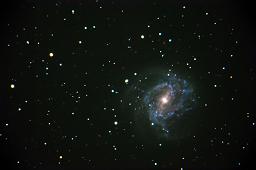
M83, the Southern "Pinwheel
Galaxy" NGC 5236
May 7, 2012
Viewing conditions are fair tonight
and I am setting up a plan to do some picture taking in the next two
days. Presently moonrise is around 11:30 PM and it rises about an
hour later each night. This gives me plenty of time to shoot pictures
before the moon washes everything out. My visual targets for tonight
were M 3, M 53. These are globular clusters just above the star Arcturus.
M3 is a 6.4 magnitude cluster and M 53 is a 7.7 magnitude cluster.
I also viewed M 92, another globular cluster in the constellation
of Hercules. For reference, the Great Cluster in Hercules is 5.9.
All of the clusters I want to photograph are in the Eastern Sky. One
Galaxy I would like to photograph is NGC 2683 the UFO Galaxy with
a magnitude of 9.7. I started my auto guider camera to see if I could
lock on to any stars in the vicinity of this galaxy. To my surprise
there are some excellent stars to guide on. I was able to view this
galaxy through the eyepiece. As I am on Vacation for the next few
days, I may attempt this galaxy after I shoot the clusters. Before
I went to bed, I could not resist a peek at Saturn. As always it is
beautiful.
May 5, 2012
Happy Birthday to me. Because it was
my Birthday, some family members got a chance to see the Observatory
first hand. My Mother and Father in Law Jim and Winnie Thompson and
my Sister in Law Winnie Loveless got to see what I was staying up
nights to view. I showed them numerous pictures and then slewed the
scope to get a view of Venus. It was 2:00 PM and the scope did its
magic. Venus came into view with a deep blue sky in the background.
I tried to see Jupiter, but it was too close to the sun and was not
visible in the day time.
May 3, 2012
Tonight some friends came to visit.
Craig and Nina Lewis wanted to see the observatory. Nina was doing
a presentation for my wife at church and Craig got the grand tour.
After the presentation was finished both Craig and Nina got a chance
to see Venus, Saturn and the Moon.
Tonight was a clear night. The only
problem, was that the moon was starting to come out and that prohibited
taking pictures of galaxies and faint nebulas. So I did the next
best thing. I took a picture of the Moon. In it's crescent form,
the moon has great contrast at the terminator where light meets
dark. The shadows on the craters are great. I also noticed that
the Globular Cluster M 5 was in the eastern sky. Since it is brighter
than M 13 in Hercules I thought I would give it a shot. The picture
turned out great and both pictures can be seen as larger size in
the Gallery. I also took some pictures of Saturn. As I do not have
the capability of projecting planets through an eyepiece and into
a camera, the result was a small picture. I enlarged the photo,
but not quite what I want. I will try stacking the photos and see
if that clears up the image. If it does, I will post it.
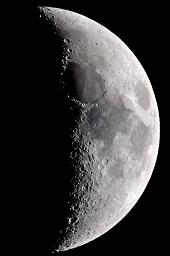 _____ _____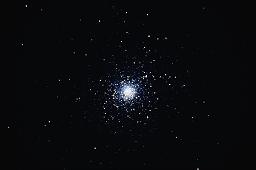 ____Crescent
Moon ______________________M5 Globular
Cluster
April 20, 2012
Finally a night that was dark and clear!!!.
I intended to begin the night by taking pictures, but I had trouble
with the computer connections to the Camera. After I got those resolved,
I accidentally turned off the power to the scope without first setting
it to "Hibernate" mode. This effectively lost all alignment
references to the mount. Therefore I spent time realigning the scope.
After the calibration, I decided to see if it was still Polar Aligned.
The scope had been bumped with different people looking at objects and
it may be slightly off. Using the Celestron All-Star Polar Alignment
procedure, I was pleasantly surprised to find that it was still aligned.
With the alignment finished, I decided
to try my luck at taking pictures and stacking them. The target was
the Whirlpool Galaxy M 51. I chose this galaxy because it is difficult
to find a guide star. I took 10 pictures at 2500 ISO for 3 minutes,
stacked them and then compared the result with the picture I took on
February 17 which was taken at the same ISO setting. The result was
similar, but the stars were more round in the stacked photo. I had some
problems with "flexure" on the February 17 picture creating
the oblong stars. I have since corrected that problem. The only advantage
I can see with stacking is when an extremely long (greater than 30 minutes)
exposure is required. Such as taking a photo of a very faint galaxy
or nebula that would require an extremely long exposure to capture the
details. Otherwise, the single exposure gives a similar result with
a much shorter time commitment. For example, it took only 14 minutes
to complete the February 17 exposure. (7 minute exposure plus 7 minutes
of noise reduction in the camera) The ten 3 minute exposures including
a dark frame took 1 hour to process. (30 minutes of exposures plus 30
minutes of noise reduction in the camera) This test is not to be confused
with the test I did on stacking April 1, described above. In that test,
I compared the stacked photo with a single shot of the same photo group.
In this case, the stacked photo brought out much better contrast and
color.
April 7, 2012
Tonight was a great night for viewing.
I received a phone call from Scott Wright a local resident of Oak City,
and he ask if he could bring his family over to see the heavens. I told
him that would be fun and to come over around 9:00 PM. There were eight
in his family and extended family. By 9:00 PM Jupiter was setting in
the west and we had to hurry to see it before it dropped below the horizon.
The nights viewing composed of:
Jupiter
Venus
Mars
M 3 Globular Cluster
M 42 Orion Nebula
Saturn
Saturn and M 42 were the highlights.
Saturn was the last object viewed as it just peaked above our eastern
mountains in time to get a good view. It was a fun night.
April 1, 2012
The weather has been cloudy lately which
makes it difficult to image or view the heavens. So with the time I
had on my hands, I did some post processing of M 42 from shots that
I took on March 9, 2012. I took a series of 9 shots and tried my hand
at stacking. Since I do not have a stacking program, I downloaded the
freeware of Deep Sky Stacker. The results are shown below.
Both images above are the same photograph.
The image on the left has 9 stacked images. The image on the right is
a single shot of only 1 of the stacked images. As you can see the colors
are more vibrant and the contrast and details are more pronounced on
the left image. Both images are using the same post processing settings.
I usually do not give full size images from this section of the web
page. But as I am not going to put this in the Gallery, you can click
on the image above for a larger comparison.
March 22, 2012
After a few weeks of cloudy weather,
and a full moon, I finally got a chance to take some pictures without
the moon washing out the photos. The Clear Sky Chart showed that the
evening would be great. However, as fate would have it, a cloud band
moved in around 9:00 PM. The clouds broke around 10:00 PM and I decided
to try and capture the Sunflower Galaxy (M63). My first attempt had
high clouds still streaming across the sky. The autoguider did not like
the clouds and gave me a warning alarm about every 30 seconds. Needless
to say, the first attempt was not good. While trying to salvage the
photo, I noticed that the autoguider which was still tracking stopped
giving the alarm. I looked out the dome and noticed that the skies had
cleared. It was getting late, around 11:30 PM, but I had to try again.
This time, the tracking was right on, and the photo was acceptable.
I will try again with lower ISO and better skies to get a better shot.
Check out the Gallery for a full size shot of this galaxy.
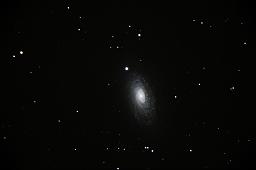 Sunflower Galaxy M63
March 3, 2012
No picture taking or visual observing
today, but I decided to do some post processing of the M42 shot that
I took on February 17, 2012. This shot was taken at f/11 through the
CGE 1400 scope at 3900 mm. This shot turned out fantastic. See the galaxy
for a full view of this nebula.
February 28, 2012
No pictures tonight, as another youth
group from Oak City came to visit the Observatory. Earlier in the day,
the sky was overcast and two hours before the tour, it actually was
blizzard like conditions at the Observatory. My son who was going to
help with the group, called me and said "Are we still going to
give the tour?" I told him to check the "Clear Sky Chart".
There was a window of clear skies beginning at 5:00 pm that would extend
to 1:00 am. It turned out the chart was accurate and the skies cleared.
The group came around 7:30 pm and there were 8 young men in the group.
The leader of the group was the Backhoe driver that set my dome on the
observatory walls. See the pictures in the "Observatory" section.
During the night, my son explained the "Astrophotography"
side of astronomy, and I was able to show them, Venus, Jupiter, M 42,
and finished up with the Moon. I hope some interest was peaked during
the tour.
The first night in 7 days that was
not cloudy. We have had snow and rain for the last week. Tonight was
my window of opportunity. I started around 8:00 PM and then high clouds
moved in and my autoguiding which I had just calibrated started giving
me errors. That's when I noticed the clouds. Around 9:00 the clouds
broke and I began imaging. I started with M 81 and 82. I got a better
shot of M81 with less noise. Then I moved to NGC 3077 which is a faint
9.9 magnitude galaxy. The picture is OK, but the galaxy is small.
I then focused my attention to M 101 the "Pinwheel Galaxy".
I think the picture is excellent. After the Pinwheel, the time was
around 2:30 AM on the 17th. I took a quick shot of M 42 at f/11 to
give a close up view of the nebula. My last endeavor was to try and
get a quick shot of the "Whirlpool Galaxy" M51. I had a
difficult time getting a suitable guide star. There were no bright
stars in the vicinity of the Galaxy. I finally got a lock on a star
that had a magnitude about the brightness of the galaxy core which
is 8.4 magnitude. With the guiding giving errors about every 5 minutes
due to the star fading in and out, I took my chance and shot for 7
minutes at an ISO of 2500. I am very pleased with the result. When
the shot ended the autoguider went into alarm and would not lock on
the star. I noticed that all of the stars including the core were
not visible in my guide camera. I looked out of the Dome Shutter and
noticed the clouds. The shot finished just before high clouds rolled
in.
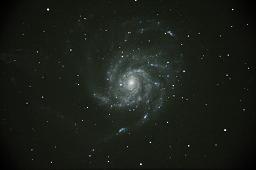 ___ ___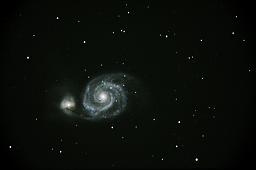
Pinwheel Galaxy M101 on the Left,
and Whirlpool Galaxy M51 on the Right
February 10, 2012
Tonight was a great night for visual
viewing. My son had his camera, so I couldn't take pictures. I did some
adjustments of the Guide Scope so that it is centered with the C 1400.
Then I played with the PHD Autoguiding Software to become more familiar
with the controls. I read on some forums that you could see more stars
in the "Trapezium" of the Orion Nebula and I decided to try
and see if I could resolve the stars. I was able to see the E Star but
not the F star. These are two stars very close to the brightest stars
in the Trapezium. I don't have an eyepiece that will give me enough
magnification to resolve the F star. Someday I will purchase a 5 mm
eyepiece which will give me a magnification of x782. I also looked at
M 81, M 82, and the Deer Lick and Bear Paw Galaxy. The Bear Paw Galaxy
was very small and dim in my eyepiece. I want to take a picture of it
and see if I can resolve some detail.
February 3, 2012
Not much viewing for the past few nights.
It has been cloudy and the moon is up causing problems with photography.
I did some visual viewing of the moon, Jupiter, and Venus, but deep
sky viewing is washed out. I did add some information to the Equipment
section of the Web Page. I now have information about my eyepieces and
the camera I use.
January 27, 2012
It has been 10 days since I have been
able to view our universe. The skies have been cloudy and there has
been at least 5 inches of snow. But tonight, everything cleared up.
It was cold at around 24 F in the scope room, but the warm room was
around 75 degrees. I had been looking at pictures on the internet of
the Bode's Nebula (M81) Not really a nebula but a Galaxy. It is around
12 million light years from Earth and a magnitude around 7.1. I have
been working on making sure I don't have any movement (Flexure) between
my Guide Scope and the C 1400. This has caused some of the "Egg"
shaped stars in some of the previous photographs. The photograph below
is good, but there is some dust on the camera CCD causing some black
splotches. I like the photo and will take more after the camera is cleaned.
I want to get the ISO down around 2500 so that some of the noise of
the picture will be cleared up when zooming in on the picture. You can
view a larger size in the Gallery.
Bode's Galaxy M 81
January 17, 2012
Tonight a group of Scouts came over to
see the Observatory. They are from a nearby town of Delta Utah. The
plan was to show them Jupiter, then M 42 in Orion, then the Andromeda
Galaxy. However the clouds moved in and all we could see was Jupiter.
My Son and I were able to describe the process of Astrophotography and
how Stellarium can control the Scope from the warm room.
January 14, 2012
Tonight was a great night for taking
pictures. No moon and clear skies. The target subject was M 33 the Triangulum
Galaxy. It was directly over head. I took one picture at ISO 2000 for
12 minutes and another at ISO 2000 for 20 minutes. The longer duration
was to try and get more detail. I did not use the f/7.1 focal reducer
as shots of this duration tend to cause a bright center and some vignetting.
Therefore I shot at f/11. At this focal length, it is difficult to get
really good tracking for 20 minutes. However, the pictures turned out
fairly good.
___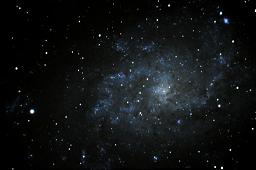 ________ ________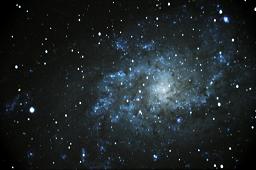
M 33 Triangulum Galaxy
Photo on the left taken for 12 minutes
at ISO 2000. The one on the right taken for 20 minutes ISO 2000. Notice
the detail difference between the two photos. Both were autoguided and
shot at f/11 using the CGE 1400 FS telescope.
January 13, 2012
I haven't had much of a chance to take
more pictures due to the bright moon. I was going to take some pictures
tonight, but decided to add a few photos to the gallery. I added the
Sculptor galaxy so that you can see it in a larger size. The one in
the gallery is at F11 and therefore a smaller field of view. I also
added the running man so that it can be seen in a larger size.
January 1, 2012
Happy New Year!!! Today was spent getting
my web site online. The Dry Creek View Observatory Web Page came on
line for the first time around 11:00 AM today. I know there is allot
of information written above, but I was keeping the blog before it was
published online. Tonight I had a neighbor boy Drake Holman come over
and I showed him how and why we take pictures. We took a quick shot
of the Sculptor Galaxy and it was quite washed out due to the moon which
was directly overhead. I then took the camera off and we tried to see
the galaxy through a 40 mm Eyepiece. I could just make it out. The picture
even though it was washed out was much better. No more pictures tonight,
just web page clean-up.
|
